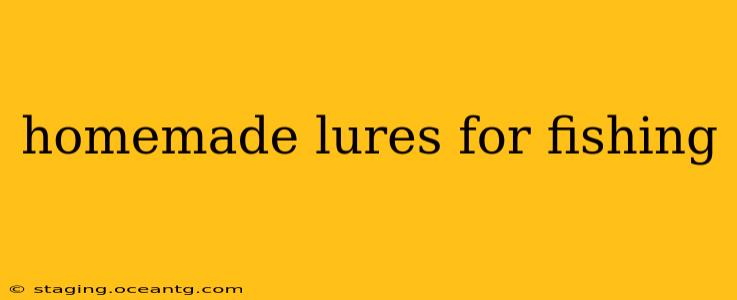Fishing is a rewarding hobby, and crafting your own lures adds another layer of satisfaction. Homemade lures can be incredibly effective, allowing you to tailor your bait to specific fish species and water conditions. This guide will walk you through the basics of creating your own fishing lures, answering common questions and providing tips for success. Whether you're a seasoned angler or just starting out, making your own lures is a fun and potentially cost-effective way to enhance your fishing experience.
What are the easiest homemade lures to make?
Some of the easiest homemade lures for beginners include spoon lures and simple spinners. Spoon lures involve cutting and shaping a piece of metal (like an old spoon!), adding a hook and some paint for attractiveness. Spinners are equally straightforward, using a spinning blade attached to a weight and hook. These designs require minimal tools and materials, making them perfect entry points into lure crafting.
What materials do I need to make homemade lures?
The materials you'll need depend on the type of lure you're making. However, some common essentials include:
- Metal: For spoon lures, you might use old spoons, metal scraps, or even lead (although lead is becoming less popular due to environmental concerns). Consider using readily available and safe alternatives like tin or other soft metals.
- Wood: Balsa wood is a popular choice for crafting various lure bodies due to its lightweight and buoyant nature.
- Hooks: Select hooks appropriate for the size and type of fish you're targeting.
- Paint: Use durable, waterproof paints designed for lures.
- Epoxy: This helps seal and protect your lure's finish.
- Eyes: These can be purchased pre-made or created using paint or other materials.
- Wire: For attaching components and creating your lure's structure.
- Fishing line: Essential for connecting your lure to your fishing rod.
How do I make a homemade fishing lure?
The process varies depending on the lure type. Let's examine a simple spoon lure:
- Prepare the Metal: Cut a piece of metal into your desired spoon shape. You can use tin snips or a hacksaw, depending on the material. Sand the edges smooth to prevent snags.
- Shape the Spoon: Carefully bend the metal into a concave shape using pliers. This creates the characteristic spoon lure profile.
- Add the Hook: Attach the hook securely to the metal, either by drilling a hole or using epoxy.
- Paint and Seal: Apply your chosen paint to the lure. Let it dry completely, then seal with epoxy for durability and water resistance.
- Add Eyes (optional): Attach artificial eyes to give your lure a more realistic appearance.
Can I use recycled materials to make fishing lures?
Absolutely! Many recycled materials can be repurposed for lure making. Old spoons, bottle caps, and even plastic containers can serve as the basis for creative and effective lures. This eco-friendly approach not only saves money but also reduces waste.
What are some tips for making effective homemade fishing lures?
- Experiment with colors: Different colors attract different fish.
- Consider the weight: The weight of your lure affects how deep it dives.
- Test your lures: Try out your homemade lures in various locations and conditions to see what works best.
- Add action: Features like spinner blades or feathered tails can enhance the lure's attractiveness and movement in the water.
- Don’t be afraid to fail: Making lures is a learning process. Don't be discouraged if your first attempts aren't perfect.
How do I make a spinner bait?
Spinnerbaits are a bit more complex but still manageable for beginners. They typically involve a weighted head, a spinner blade, and one or more hooks. Detailed instructions can be found in online tutorials or books specifically focused on lure crafting.
By following these guidelines and experimenting with different designs and materials, you can create effective and unique homemade fishing lures that will enhance your angling adventures and potentially even out-fish commercially produced lures! Remember to always prioritize safety when working with tools and materials. Happy fishing!
